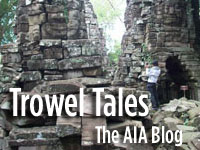Where Did Sunflowers Come From?
by Heather Pringle
June 28, 2008
 Archaeologists always take a keen interest in the origins of things—whether it’s the beginnings of civilizations, scripts, sailing or even shoes. There’s an undeniable cachet to excavating the oldest and the earliest of anything, of course, and, as I can attest, the media loves these stories. But beyond fame and glory, many archaeologists feel a deep sense of wonder and delight in these excavations, glimpsing again the ingenuity and endless inventiveness of humanity.Â
Archaeologists always take a keen interest in the origins of things—whether it’s the beginnings of civilizations, scripts, sailing or even shoes. There’s an undeniable cachet to excavating the oldest and the earliest of anything, of course, and, as I can attest, the media loves these stories. But beyond fame and glory, many archaeologists feel a deep sense of wonder and delight in these excavations, glimpsing again the ingenuity and endless inventiveness of humanity.Â
         In the case of agriculture, however, archaeologists have an even more pressing reason to search for origins. Climate change, with its scorching summers and long months of drought, is wreaking havoc in farmers’ fields around the world. To make the best of these harsh new conditions, botanists are trying to breed hardier and more resilient plants. But this requires genetic data from early plant stocks—ones that were first domesticated by humans. In other words, we need to know exactly where our crops came from, so that botanists can breed new and better cultigens for the future.Â
         Which brings me to four important letters that will appear soon in the Proceedings of the National Academy of Sciences (PNAS). Archaeobotanists have been battling for some time now over the origins of the sunflower—the source of an important cooking oil. Earlier this year, David Lentz, a botanist at the University of Cincinnati, and four colleagues published new evidence to support his contention that the sunflower was first domesticated in Mexico about 4600 years ago. One of their main pieces of new evidence was linguistic: they pointed out that indigenous groups in Mexico, including the Otomi and Nahua, coined their own words for sunflower, instead of borrowing them from the Spanish. This, they concluded, proved that Mexico’s aboriginal population knew the sunflower before the Spanish arrived.
         The new letters written by a linguist, a biologist, two geneticists and an archaeologist, now poke gaping holes in these arguments. Linguist Cecil Brown notes, for example, that the terms for sunflowers in 11 native languages in Mexico are all descriptive like “big sun†or “shield flower.†Such terms, says Brown, describe “newly encountered, introduced things.† Indeed, they are similar to the phrase “cacao bean of the earth,†which was coined in Mexico to describe peanuts brought from South America.
         All this raises huge questions about Lentz’s claim that ancient Mexicans first domesticated the sunflower. It now looks as the honor should once again go to Native Americans, who began planting and reaping the colorful crop at least 3300 years ago in the eastern United States.
Comments posted here do not represent the views or policies of the Archaeological Institute of America.






 Heather Pringle is a freelance science journalist who has been writing about archaeology for more than 20 years. She is the author of Master Plan: Himmler's Scholars and the Holocaust and The Mummy Congress: Science, Obsession, and the Everlasting Dead. For more about Heather, see our
Heather Pringle is a freelance science journalist who has been writing about archaeology for more than 20 years. She is the author of Master Plan: Himmler's Scholars and the Holocaust and The Mummy Congress: Science, Obsession, and the Everlasting Dead. For more about Heather, see our 



